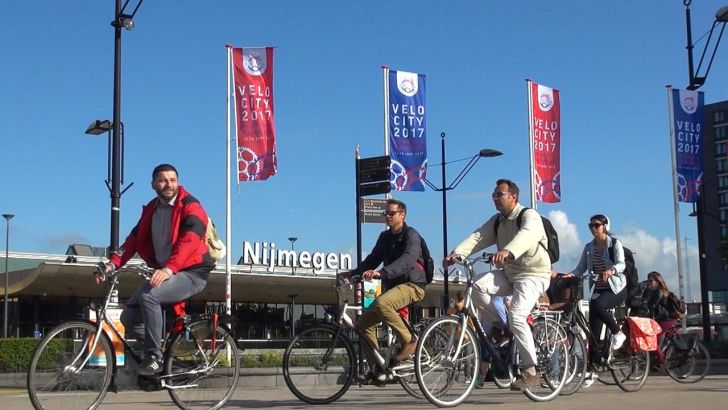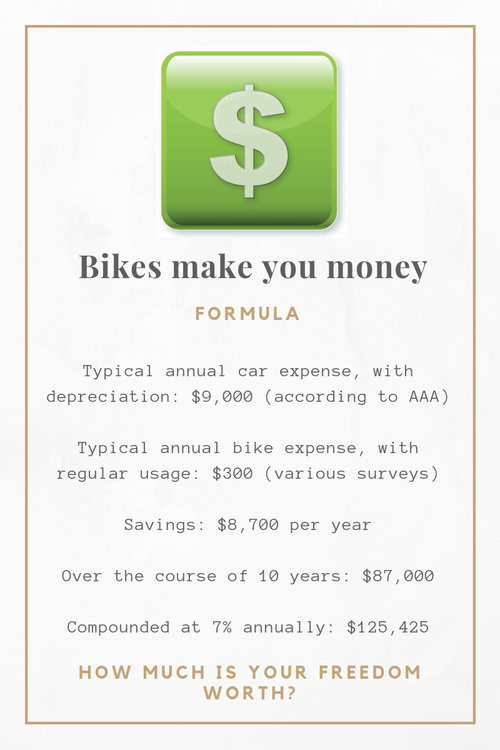Your truly autonomous future: bicycles, personal mobility and learning from the Dutch
This Fall, I had the good fortune of traveling with my family for about a month in the Netherlands, Belgium, France and a small bit of Germany. I’ve been lucky enough to take several trips overseas, but still every trip is illuminating. New lessons are learned. New experiences are had. I’m a yuuge proponent of travel as a means for educating yourself and for bettering the world. Yes, I know all the critiques of mass tourism, but nothing connects our human tribes better, opens the mind and breaks down stereotypes than to actually get out of one’s own bubble for a little while.
I’ve shared this before, but it’s worth another share. A great short film by Streetfilms about the small Dutch city of Nijmegen
While I do plan to ultimately address several topics, I wanted to focus specifically on our experience in the Netherlands first. The Dutch are by now famous for their culture of biking, and have become a global destination for those looking to understand a different approach to transportation planning and cities. And, with good reason. It’s amazing; there’s no other way to begin describing it. Most of Europe has a more advanced biking culture than the US, but the Netherlands is on its own plane. Visiting the Netherlands for biking is the equivalent of visiting France for wine. It’s a pilgrimage of sorts, and you won’t be disappointed.
First things first – go experience it
We spent a week in the city of Haarlem (the namesake for Harlem in the US), which is a short, fifteen-minute train ride outside of Amsterdam. It’s a charming and beautiful city, and I highly recommend it as a gateway to the entire region. If you go and you’re into beer, you must visit Jopenkerk. Most of our stay was spent walking or taking public transportation, but we did get on some bikes and ride as well. If you’ve read much on the topic and the Dutch biking culture, you know how complete and transformative their approach is. For example, the Dutch don’t wear helmets, and nearly all bikes are the sit-upright variety. Protected and dedicated bikeways are ubiquitous, as are the many woonerfs, or shared streets, in the cities. Even out in the countryside, you’ll find dedicated bikeways paralleling roadways or along their own paths. Kids, moms, businesspeople – you’ll see all of them riding bikes daily.


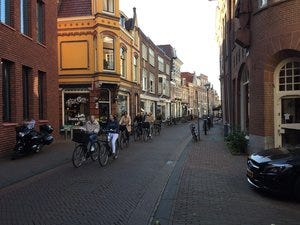

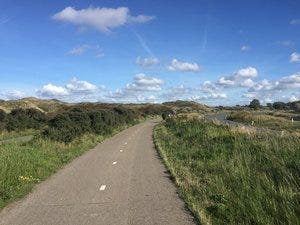



Most of this isn’t new information to people in the planning or transportation world, since copious articles, videos and books have been written on the topic. Still, experiencing it is something else entirely. Lived experience is always the most illuminating and long-lasting. At one point, I tweeted this, since I want many others to benefit from the same experience:
For this piece, I want to focus on a few observations that I took away from it all, and what it might mean for American cities and towns. First, I’ll just say that I absolutely love what the biking culture does for cities. That may sound unremarkable, but you have to understand that this is a fairly dramatic turn for me philosophically. Ten or fifteen years ago, I never would’ve talked about bicycles as a priority for making great places. Frankly, I often pooh-poohed it. I found the demands of bike advocates to be annoying, and often anti-urban. With streets that often lacked the basics such as on-street parking and street trees, why would I care about the needs of a tiny handful of people that choose to ride a bike? Won’t our slower street designs make it safer for everyone?
Well, yes and no. Slower street design, especially on quiet, residential streets does work well for everyone. And, like any special interest, bike advocates can take it too far with ideas that are “anti-urban,” as we sometimes say, or work against a successful big picture. But in most respects, I’ve come around completely to the needs of cycling, and the importance of first-class, dedicated infrastructure.
Three aspects in particular stood out from this trip. The first is how ubiquitous biking truly enables compact urbanism in our modern world. In the older cities, you find living, working examples of the kind of skinny streets we often put on postcards. These places simply can’t happen today if we have to accommodate cars. And not to put too fine a point on it: they are incredible, wonderful, livable places. Skinny streets are awesome for kids, who can safely run free. They enable a compact form of community that is still essentially low-rise and dense enough to support neighborhood shops and services. Copious biking and walking is the key that unlocks this. Neither alone can do it. There has to be a form of transportation that can cover a distance of up to two or three miles, since people don’t typically live solely within a ¼ mile radius.

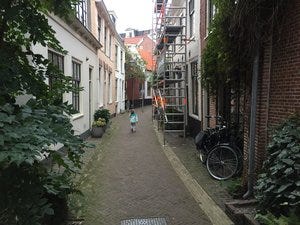


Second, it’s remarkable how quiet the cities are. Even Amsterdam is quiet for a large, bustling city. I’ve written this before when it comes to snow days, but we forget just how much of city noise is vehicular noise. When those sounds are drastically reduced, it’s shocking how quiet cities can become. It’s almost un-nerving at first, since we’re not used to it. Why does this matter? Again, it’s all about the real needs of humans. I love the energy of the city and the bustle of people. But I also love quiet moments to just sit and read or be alone. One reason our single-family neighborhoods are so popular is because of the quiet that is provided at the end of long, often stressful days. Sleep is easier, too. We can do that in cities, too, if they aren’t over-run with vehicular noise.
Personal Mobility: The under-appreciated aspect
But last and most importantly, is the aspect of personal mobility. I think we have long under-estimated (and continue to underestimate) how bicycles enable the sort of personalized transportation experience that most of us crave. Cars do many things for us we love, but one thing that really stands out in America is how the car has become an extension of our personality. We choose one based on our personal preferences, we customize it in some way, and we listen to our own music. It’s our own, individualized transportation device. The fetish of PRT (Personal Rapid Transit) has long been about trying to combine that individualized experience with a more efficient means of moving the cars on some form of track. It’s a fantasy, a silly and expensive one in my opinion, but it’s based on the notion of individual human experience.
Here’s the thing: bikes can do almost all of the same things. You don’t really see that, until you’re in a place like the Netherlands where everyone rides a bike. The customization is remarkable.


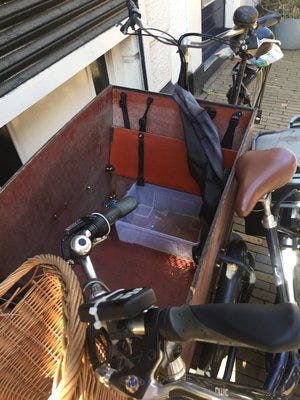

The benefits of choosing a bike instead of a car are obvious: it’s far cheaper, you get some exercise and fresh air, and you can often navigate a tight city grid more easily. Parking is almost never an issue (except when it’s uber-popular as in many Dutch cities). The downsides are obvious, too: you’re out in the weather, you have to deal with topography and long distances can be a problem. But all of those are trade-offs for the individual depending on what a person’s needs are.
We like to complain about the weather, but if the distances are short enough (say, under two miles), the time goes quickly. And how long does it take your car to warm up on cold days? My experience living in places with winter was almost always that the car didn’t really heat up until I got right to my destination, even when having a garage. Most of our car trips are shorter than we realize. The Danes also have a robust biking culture, and Denmark is colder than nearly all of the continental US.
The beauty of the bike is that it’s personal, like the car. You can make it your own. You can make it electric. You can add storage. You can add funky design. You can add music for your own tastes. You can go at your own pace, or take your own route. There are just so many advantages over a tech-fetish AV approach, where we all ultimately become like the people in the movie “Wall-E.”
There’s also the small matter of: you’ll literally save thousands and thousands of dollars per year riding a bike instead of driving. The notoriously frugal Dutch (it’s a country that doesn’t even really use credit cards) inherently understand this. Causation is impossible to prove, but the popularity of biking clearly plays a role when a group of people are focused on ROI, debt and frugality.
All of this to say, this is why I’m so bullish on bikes as a recipe for the future of cities instead of AV’s, and even grandiose transit schemes, to a lesser degree. Bikes speak to the individual, and its needs much better. They enable us to just get out and go, immediately. E-bikes can deal with the hills. The weather? Well, maybe we just need to stop being crybabies like Mr Money Mustache says and suck it up. It’s good for us!
As someone with nearly five decades of life experience in North America, I’m greatly skeptical of our individualist culture fully adopting ubiquitous public transit or letting robot taxis drive us around everywhere. I certainly support more transit, and hope for the best, but I’ve long ago come to realize in most American cities it can only serve a small, niche area well. For many grown-ups today, bikes are not even considered as a means of serious transportation. I get that. Living in most of America, it’s very, very hard. But I can see this changing, too. In fact, it’s already changed a great deal in the last twenty years.
What does it all mean for American cities and towns? Dream big, act strategically and incrementally
Today, honestly, going to the Netherlands is about allowing yourself to dream. We are mostly starting from scratch in our cities. Even the places that have a so-called great biking culture have decades of work to do to approximate what the Dutch have. We’ve poured our resources into cars and driving, and the results are on the ground all around us.
There are certainly technical details to discuss that can be copied. I loved the way roundabouts are designed with separated bike lanes; the street intersections that are speed tables to slow the cars; the way pavement is handled in the woonerfs; the pavement treatments common in separated bike lanes – all of it and a hundred more details are important to look at and learn.
But in the US in particular, the challenge is cultural and political. The voices of commuters are very strong in this country. Commuting by car is the foundation for all transportation planning here, and it cuts across all political tribes. Even many of our best urban neighborhoods are sliced and diced with high-speed roadways, rush-hour parking limitations and subsidized parking all designed for the benefit of long-distance car commuters. Politicians that push back against commuters often find themselves to be former politicians.
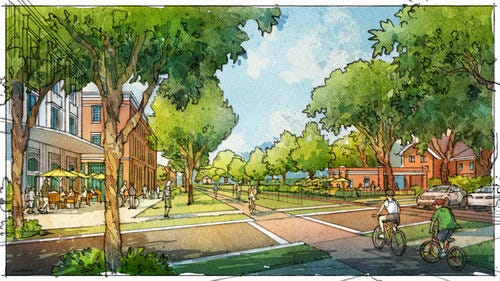
So what to do then? Is it all hopeless? Do we wait for the revolution?
No, of course not. Like most good work, change has to be incremental. Convincing entrenched interests is not a good strategy nor wise use of anyone’s time. Work with the open-minded and the younger people in your community. I’d suggest using the lessons learned from places that do it really, really well, and making changes to a particular neighborhood or small group of neighborhoods first. Focus your energies and team. Be very strategic. Work on a few long-distance routes with protected bike lanes where you can actually win. Gradually expand out. Find ways to push cars and parking to the periphery of your target areas, so pedestrians and bikes can become the norm.
Our cities and towns won’t look like Dutch cities and towns. We don’t have many 400 year old neighborhoods, nor the urban culture that supports them. It is likely most North American cities will have a protected bike lane or a small network of them a decade from now. Some will obviously be much further ahead. That’s great, and it’s important progress. But it’s still mostly a commuting mindset even with bikes, and not a lifestyle mindset. If we want to find our own, unique version of what the Dutch have, at least for that portion of the market that really wants great urbanism, we’ll all need to think of the bigger picture. My own takeaway from visiting the Netherlands has been to understand, first-hand, how a network of great biking can enhance what I love about cities. Whether it’s the sound of ringing bells (instead of car horns), the eye contact of actual humans, or the crazy bike customizations, I enjoyed it all. It hits all my hot buttons of practicality, freedom, whimsy and kid-friendliness. It makes the neighborhood shop or café more viable, and the public space immensely more pleasant. I’d encourage you to take your own journey, and tell your friends and family what you’ve learned. That’s how change happens.

